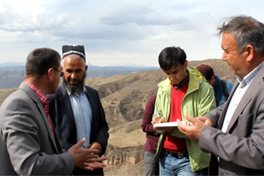 Community-based planning for integrated watershed management in Muminabad.
Photo: Willem van Werperen
Community-based planning for integrated watershed management in Muminabad.
Photo: Willem van Werperen
Tajikistan is highly vulnerable to natural hazards that can cause disasters. Due to its mountainous terrain, the country frequently experiences disasters related to rainfall, such as floods and landslides, but also dry spells. At the same time, farming and firewood collection are widely practised in ecologically fragile areas, such as the upper zones of watersheds. Inadequate land management practices result in soil degradation and increased water runoff, which alters the water balance and increases the risk of disaster. Integrated Watershed Management (IWSM) uses sustainable land management (SLM) practices to manage trade-offs between immediate human needs and the protection of ecosystems in watershed areas.